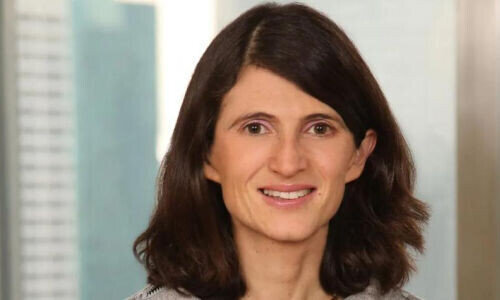Ralph Hamers – Surfing the Interest Rate Wave
The head of UBS speaks about the adverse environment for the world's largest private bank. But there is one wave bankers can ride without much effort as finews.com shows.
1. New Paymaster's Trial by Fire
On Tuesday, Sarah Youngwood (pictured below) presented UBS's 2022 quarterly and half-year figures for the first time. The dual French-American citizen has been chief financial officer (CFO) of Switzerland's largest bank since May of this year, taking over in that role from longtime Kirt Gardner, who left the company. Youngwood did not have an easy debut given the turbulent global political and economic situation.

(Image: UBS)
The appointment is a strong indication that bank CEO Ralph Hamers wants to attract more female and technology-savvy talent to the top management team. Youngwood's commitment is also a signal that UBS sees large American banks as its biggest competitors and wants to play on the same level with them. On Tuesday, the new CFO presented a decent set of financial statements given the circumstances, but investors did not appreciate them, pushing share price down temporarily by more than 6 percent. Youngwood reiterated that UBS would buy back shares worth a total of $5 billion by the end of 2022.
2. For Once, Growth Market bets Don't Pay Off
Divestments in Austria and Spain are the best proof of this: In its core wealth management business, UBS is betting on the regions seen as having the greatest potential in the future, which are first and foremost the Americas and Asia-Pacific. Nevertheless, it is a bet, and client activity declined significantly in both markets. For now, it is a tale of two regions. While the US experienced tax-related money outflows, Asia bagged $3.3 billion dollars in new money.
Still, in terms of revenues, Asia made the smallest contribution to the UBS pie, while the Americas region made the largest at 40 percent. To be sure costs, particularly in the US, are still very high, bearing in mind that the Americas contributed only 23 percent to the Group's pre-tax profit. This is significantly less than the 33 percent generated in Switzerland and only slightly more than the 22 percent in the Asia Pacific region, and Europe, Middle East, and Africa (EMEA) region at 21 percent. Morevor, at 90.6 percent, the cost/income ratio (CIR) of America's business is substantially worse than the other regional markets.
3. Share Price Turning Point?
Even for a UBS that had excelled quarter after quarter in recent years, these are trying difficult times. Although managing to post a hefty profit, it was less than investors expected and they sent shares lower, at one point dipping more than 7 percent over the course of the day.
Taking a deeper look, income from a joint venture sale in Japan helped make its half-year results more presentable. Furthermore, if the Swiss business was not so stable, even more investors would likely be voting with their feet or selling their shares. But the night is darkest before the dawn, and UBS's top management expressed cautious optimism on Tuesday, expressing hopes of benefitting from rising interest rates and a corresponding interest margin, and continuing a share buyback program worth a total of 5 billion francs through the end of 2022.
But will this be enough to convince investors? For once, UBS does not have its fate entirely in its own hands given the current economic and political environment.
- Page 1 of 2
- Next >>




























